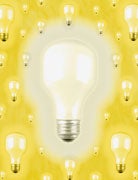 India is well-known for its power problems. The country has an installed capacity of 174,361 megawatts for its billion-plus population. According to the Central Electricity Authority (CEA), in the fiscal year 2010-2011, India’s energy shortage was 8.5% and its peak shortfall was 9.8%. CEA has projected an energy shortfall of 10.3% and a peak shortage of 12.9% for fiscal 2011-2012.
India is well-known for its power problems. The country has an installed capacity of 174,361 megawatts for its billion-plus population. According to the Central Electricity Authority (CEA), in the fiscal year 2010-2011, India’s energy shortage was 8.5% and its peak shortfall was 9.8%. CEA has projected an energy shortfall of 10.3% and a peak shortage of 12.9% for fiscal 2011-2012.
The situation is expected to only worsen. With industrial and urban expansion, growth in household consumption and electrification of rural areas, power requirements are on the rise. It is estimated that India’s demand for power will soar to as much as 315,000 megawatts by 2017. But new generation capacity is not coming online as fast because of the inevitable delays related to permissions, acquiring funding and construction.
Environmental concerns, too, have come to center stage and are impacting the progress of upcoming power projects. One example: bidding for the 4,000-megawatt power project at Surguja in Chhattisgarh has been held up for over a year. The Fukushima nuclear power plant meltdown in Japan in the aftermath of the earthquake and tsunami earlier this year has increased the concerns around the proposed 9,900-megawatt nuclear plant in Jaitapur in Maharashtra.
According to a study by consultancy McKinsey, the power deficit in India could be as high as 25% by 2017.
Interestingly, some companies — including multinationals — see this as a business opportunity. They don’t aspire to solve macro problems; they are looking at tackling the micro end of the issue and making a profit in the process.
Take Atlanta-based beverage giant Coca-Cola. It recently piloted eKOCool, a solar-powered cooler with a capacity to store 48 glass bottles of 300 ml each, in Uttar Pradesh in North India. The cooler, which can also charge mobile phones and solar lanterns, has been developed by the firm’s India team. Talking to the news daily, The Times of India, Asim Parekh, vice president, technical, for Coca-Cola India said: “The eKOCool is an outcome of our technical team’s persistence to use renewable energy for operating cooling equipment. The rural markets pose challenges in expansion as a huge swath of the rural belt is not yet covered by the power grid and hence remains without electricity or has low power.” Parekh believes that eKOCool will give Coca-Cola “a competitive edge as well as a first mover advantage.”
Others have spotted similar opportunities in the Indian market. Finnish mobile handset maker Nokia has come up with longer-lasting batteries; Dutch electronics maker Philips has introduced solar lamps and GE Healthcare has devised electrocardiogram machines that can operate on batteries.
Indian companies, too, are on the bandwagon. The Swatch water purifier from the Tata Group; the ChotuKool refrigerator from Godrej & Boyce and Studylite, a study lamp for children from BPL, are all innovations that seek to fulfill consumer needs in the face of power shortages.
Vijay Govindarajan, a professor of international business at the Tuck School of Business at Dartmouth College, points out that constraints can actually be liberating. “In the West, we assume abundant power supply and create products that can use that power. What do you do in rural India, where electricity is either unavailable or unreliable? You can either wait for power to become abundant or just innovate under constraints. If necessity is the mother of innovation, constraints are a boon, not a curse.”
Of course, there is another challenge for companies: To make these products affordable for the masses.



